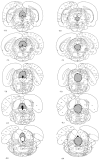Distinct regions of the periaqueductal gray are involved in the acquisition and expression of defensive responses
- PMID: 9547249
- PMCID: PMC6792664
- DOI: 10.1523/JNEUROSCI.18-09-03426.1998
Distinct regions of the periaqueductal gray are involved in the acquisition and expression of defensive responses
Abstract
In fear conditioning, a rat is placed in a distinct environment and delivered footshock. The response to the footshock itself is called an activity burst and includes running, jumping, and vocalization. The fear conditioned to the distinct environment by the footshock elicits complete immobility termed freezing. Lesions of the ventral periaqueductal gray (vPAG) strongly attenuate freezing. However, lesions of the dorsolateral periaqueductal gray (dlPAG) increase the amount of freezing seen to conditional fear cues acquired under conditions in which intact rats do not demonstrate much fear conditioning. To examine the necessity of these regions in the acquisition and expression of fear, we performed five experiments that examined the effects of electrolytic lesions of the dlPAG and the vPAG in learned and unlearned fear. In experiment 1, lesions of the vPAG strongly attenuated, whereas lesions of the dlPAG enhanced, unconditional freezing to a cat. In experiment 2, lesions of the dlPAG made before but not after training enhanced the amount of freezing shown to conditional fear cues acquired via immediate footshock delivery. In experiment 3, vPAG lesions made either before or after training with footshock decreased the level of freezing to conditional fear cues. Neither dlPAG lesions nor vPAG lesions affected footshock sensitivity (experiment 4) or consumption on a conditioned taste aversion test that does not elicit antipredator responses (experiment 5). On the basis of these results, it is proposed that activation of the dlPAG produces inhibition of the vPAG and forebrain structures involved with defense. In contrast, the vPAG seems to be necessary for postencounter freezing defensive behavior.
Figures






References
-
- Applegate CD, Kapp BS, Underwood MD, McNall CL. Autonomic and somatomotor effects of amygdala central nucleus stimulation in awake rabbits. Physiol Behav. 1983;31:353–360. - PubMed
-
- Bandler R, Shipley MT. Columnar organization in the midbrain periaqueductal gray: modules for emotional expression. Trends Neurosci. 1994;17:379–389. - PubMed
-
- Behbehani MM. Functional characteristics of the midbrain periaqueductal gray. Prog Neurobiol. 1995;46:575–605. - PubMed
-
- Bellgowan PS, Helmstetter FJ. Neural systems for the expression of hypoalgesia during nonassociative fear. Behav Neurosci. 1996;110:727–736. - PubMed
-
- Blanchard RJ, Blanchard DC. Crouching as an index of fear. J Comp Physiol Psychol. 1969;67:370–375. - PubMed
Publication types
MeSH terms
Grants and funding
LinkOut - more resources
Full Text Sources
Other Literature Sources
Miscellaneous
